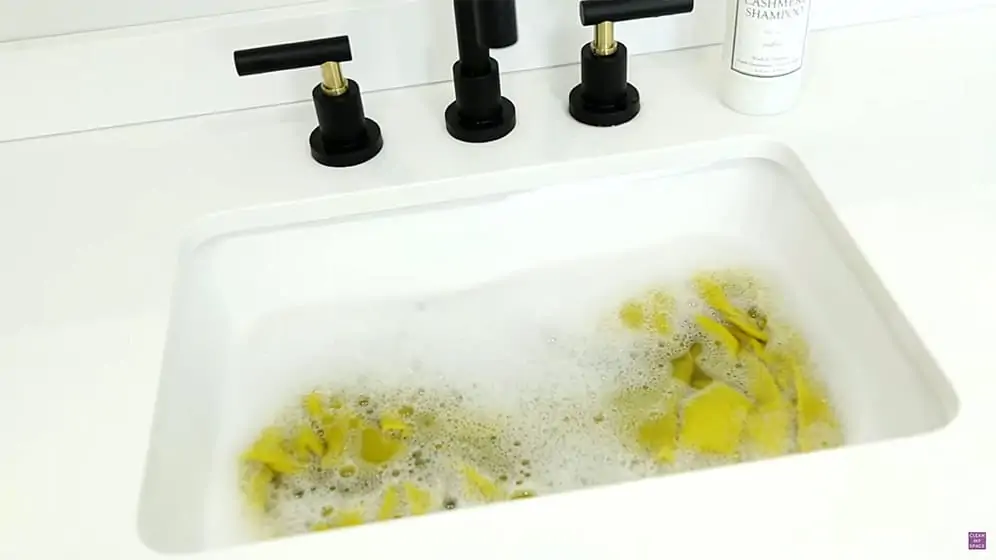One of the things I do now whenever I buy something is check the fabric care label to see if I can really handle the maintenance of the garment. If it’s too much work or too expensive to maintain, I don’t want to own the item—it’s just too exhausting. But, there are times where really gorgeous things can be cleaned without worry at home. We just need to know how to do it properly. So let’s explore what really has to be dry cleaned, and how to hand wash silk, cashmere, and wool at home.
Hand Washing vs. Dry cleaning
Before we get into the techniques, let’s discuss what really has to be dry cleaned vs. what can be washed at home.
What Can You Hand Wash?
Many designers place dry clean only labels on their garments to protect themselves from you making a washing mistake (!). The materials they use may wear faster or require special attention, which is why they say to dry clean them. Laundering in a machine can be harsh on fabrics and pill or stretch fabrics, leading to the garment looking worse for wear after washing. Further, many people just aren’t well-versed in how to clean these fabrics which is why a dry clean only label is used—it just helps prevent errors. Many of these materials are completely washable at home. So when you see a delicate or ‘dry clean only’ garment made with wool, silk, cotton or cashmere, you can wash them at home so long as you perform a test on the garment first to ensure there’s no color bleeding, shrinkage, warping, or other naughty garment behaviour. If you see something odd, take it to the dry cleaner!
The Laundress also has a handy Fabric A-Z guide on their website where you can search fabric names to find out if they’re in fact able to be laundered at home.

Dry Clean Only—For Real!
Certain fabrics can only stay intact if they’re dry cleaned. I have made the mistake of thinking I can hand wash something only to totally ruin it. Fabrics made from viscose, acetate, taffeta leather, suede should not be machine washed. Further, consider the structure and embellishments of the garment. Pleating (I’ve made this mistake!), shoulder pads, or other structural elements can be ruined if washed, as well as delicate appliques, certain sequins, glued-on beading or other flashy elements.

How to Hand Wash Wool and Cashmere
I had a wool cardigan years ago that I bought at Anthropologie. I washed it using warm water, in a machine, and it was a disaster—it came out perfectly-sized for a two-year-old! It was comical to look at but sad to deal with because I thought I had done the right thing. Just a quick mention here, the same technique can be used to clean silk, save the vinegar step and using the right detergent (more on both, below).
Pre-treating stains and odors
As always, start by pre-treating any stains and/or odors; Use a safe stain remover solution and apply it gently to the stained area. You can also add this to areas you know get easily stained like cuffs, collar areas, and underarm areas. If you find the garment has an odor to it you can soak it in a solution of ¼ cup of white vinegar and room temperature water for 30 minutes (always turn garments inside out) and note, I don’t recommend doing the vinegar soak for silk. I generally group my garments together by color category (lights, colors, darks) and have up to three bins going at a time when I’m in a handwashing mood. Remember, cold water only, and gentle hand movements so as to not stretch, pull or twist the fabric.

Hand washing
Once pre-treating is complete you can start cleaning. To do this add 2 capfuls of pH neutral delicates cleaner to a basin or sink filled with cool water (I like using The Laundress products because they have a line of scientifically formulated toxin-free laundry detergents to wash and preserve garments for great at-home results). Next, add the item and gently saturate and work through the water—avoid rubbing and twisting, I like to squeeze the item in different areas with my hands several times to get everything soaked nicely. Then, you can let the garments sit for up to 30 minutes. You might notice the water darkens, this is normal, it’s simply dye run-off and won’t affect your garment.
When this is done, dump out the basin and press each garment against the side of the basin to remove as much water as you can. Remember, no wringing or harsh moves to get rid of water. Run cool water and rinse each garment, pressing it as you go to soak the clean water through the material. When the water runs suds-free, you know you’re all done.
Drying
To dry, place a fresh towel out and lay the garment flat onto the towel. Roll up like a burrito to help remove excess moisture and lay flat to dry. We don’t like to hang these garments because it can misshape them. So find a place to lay them flat, such as a drying rack with mesh inserts.
To keep pieces wrinkle-free and fresh between washes, choose steaming over ironing (which can flatten the yarn). Further, a wool and/or cashmere spray can help to freshen things up.

How To Remove Pilling
If you notice pilling, you can use a sweater comb on wool or cashmere, or pumice stone on larger knits. Always work in once direction and use short strokes to comb the pilling off. This is why people buy expensive sweaters—they last for years when cared for properly and stay fashionable and warm season after season.
How to Machine Wash Silk
Generally speaking, silk is fine to be hand-washed, but be aware of how easy it can shrink or be ruined by heat. It can also be degraded by perspiration, oils, creams, and is not as resilient as other materials we might like to wear. But it’s really nice to wear (or sleep on) because of its beautiful, luxe look and feel. Cleaning it can be simple, but it must be done right. First, test it by dipping a small corner or seam into cool water and watch for a reaction; shrinking, wrinkling, puckering, wrinkling, color bleeding—any reaction to water indicates it’s not a good candidate for hand washing. If the garment passes the test, proceed to pre-treat stains with a safe stain product or bar.
You can hand wash it the same way as the wool and cashmere method I explained above, however, in this instance I’ll explain how you can machine wash silk, and note that you can also use this method for wool and cashmere, although I want to reiterate that hand washing is always preferred.
Machine WashingSilk
To machine wash take a garment bag and lay the item (remember to pre-treat as above!) inside out, and flat, in the bag. Add the appropriate amount of delicates detergent (again, I like to use The Laundress’ detergents for this) and place your machine on a delicates cycle, using cold water and low spin.
Drying Silk
When the wash is done, remove at once and lay flat to dry. Again, it can misshape if hung and can NOT be placed in the dryer. Expect wrinkles, and either iron on the lowest possible setting using a pressing cloth between the iron and the garment (just a clean, thin cotton cloth) or preferably, use a garment steamer.
And that’s it! Not as scary as you thought, right? The most important takeaways here are to always use cold water, be gentle when handwashing, never use a dryer, and invest in the right product for the job at hand.
A special thanks to The Laundress for partnering with us on this tutorial, to learn more visit their website. You can use the code CLEANGIFT at checkout to receive a FREE 2oz Delicate Wash with your order.
Looking for a BETTER & EASIER Way to Clean Your Home?
Cleaning Expert Melissa Maker is here to help with her game-changing 3 Wave Cleaning System that will help you clean your house faster and easier than you ever thought possible!


















the good blog, the Leave a Legacy is not going away forever.
Very informative thanks
What kind of towel do u use? Doesn’t look like a cloth I seen the video on YouTube.
Can you remove water from a wool or cashmere sweater by placing it–in a non-stretched way–against the side of an empty washer and then using just the spin cycle? I’ve had some good luck with this with cotton sweaters, which are often stretch-prone. They’ve come out with no stretching, but I’m not sure about cashmere especially.
For delicate fabrics, I use hand washing.
Thanks for sharing with us!
Verry good Content For Reading , thanks for sharing with us
Hey Melissa, do you know how to remove slime from a cashmere sweater?
Hey Melissa, thanks for sharing these points on washing woolen, silk & cashmere clothes.